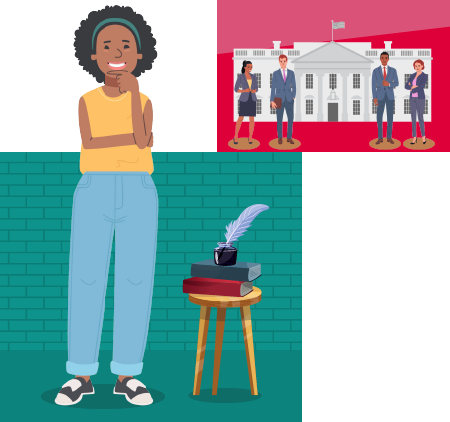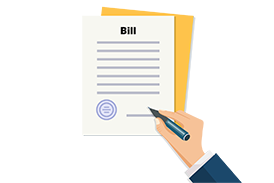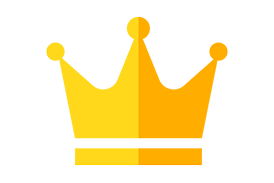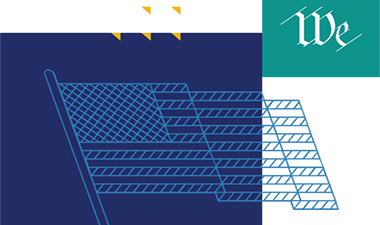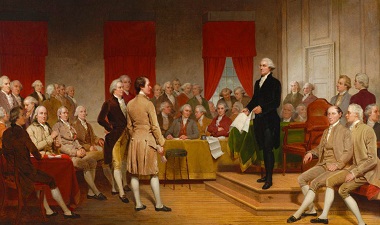
Getting Started
This module includes an Unboxing the Constitution video (5 min), Inside the Constitution video (5 min), student activities, and a learning project. Download the Teachers Guide and the Student Content Guide for more details on content and implementation. Course materials are provided in Google documents, Word documents, as well as printable PDFs.
A preview of the module can be accessed below.
Topics covered include:
- Presidential powers
- The Cabinet
- Executive Orders
- Impeachment

Vocabulary
At the beginning of each module, students are presented with vocabulary words and definitions.
Concept Words
Concept words are conceptually related to the big ideas in what they’re learning. These connect directly to the core concepts or themes of the lesson or unit. Red terms help students grasp the main ideas and how everything fits together.
- cabinet: the group of department heads and other key officials who help the president manage the executive branch and make important decisions elector: a person who has the right to vote in an election, especially someone chosen to vote in the Electoral College for the President and Vice President
- executive order: a rule made by the president that has the power of law
- execute: to put something into action, such as a law
- Federal Reserve: the central bank of the United States, responsible for managing the country’s money and controlling interest rates
- infringe: to violate or break a rule, law, or right
- impeachment: the process of formally charging a government official, like the President, with misconduct or wrongdoing; if impeached, they may be put on trial to remove them from office
- natural-born citizen: a citizen by birth
Speed Bump Words
Speed bump words are words that aren’t central to the concept being taught, but if students don’t understand them, they may struggle to comprehend the text or lesson. These words can help shape students' overall understanding of the topic.
- circumvent: to find a way around something, like a rule or an obstacle
- concur: to agree with someone or to have the same opinion about something
- corruption: dishonest or unfair behavior by someone in power, such as lying, cheating, or taking bribes
- diplomacy: managing relationships and solving problems between countries
- negotiate: to talk with others in order to reach an agreement
- strike: when workers stop working as a protest to demand better conditions or wages at their place of work
- treaty: a written agreement between countries

Topic 1: The Role and Responsibilities of the Executive Branch
Article I of the Constitution states that Congress is responsible for creating laws. Article II of the Constitution explains that the responsibility for enforcing those laws lies with the executive branch of the national government. Article II “vest[s]” the “executive Power . . . of the United States” in a single president. To many, the president is the most powerful elected official in the United States. In some ways this is true. However, the Constitution actually grants far fewer explicit powers to the president in Article II than it does to the Congress in Article I. Article II sets out the details for how a president is elected and how a president might be removed from office. It also lists some of the president’s core powers and responsibilities.
8.1: Activate Prior Knowledge
To start engaging with the content in this module, students will collaboratively brainstorm words, names, and phrases related to the Presidency.
Unboxing the Constitution
In this Unboxing the Constitution video, Lucy explains key concepts related to Article II and the Presidency.
8.2: The President
Students explore the role and responsibilites of the President. Find discussion tips in the Teachers Guide and content in the Student Content Guide.
8.3: The President's Cabinet
Who is part of the President’s Cabinet? Explore the departments, agencies, and individuals who support the President.
8.4: Article II Scavenger Hunt
Students will explore Article II of the Constitution to find the structure, power, and limitations of the executive branch by exploring sections of Article II.
8.5: Closing Activity
Students will check in on the Key Question(s).

Topic 2: Presidential Powers and Limits
During the Constitutional Convention, the founders wrestled with a critical question: how to create a government strong enough to unify the nation while avoiding the tyranny they had fought to escape. One of the hardest decisions was figuring out the role of the president. The delegates debated how much power a single executive should hold, how to balance that power with the other branches, and how to ensure accountability to the people. These discussions ultimately shaped Article II of the Constitution, which establishes the framework for the executive branch.
8.6: Key Debates
Find background in the Student Content Guide and implementation instructions in the Teachers Guide.
Watch the Inside the Constitution video to gain insight into the debates around the creation of the presidency during the Constitutional Convention.
Inside the Constitution
8.7: What is the Electoral College?
How is the President elected? Learn more about the Electoral College, a structure that is unique to the electoral process in the United States. Find background in the Student Content Guide and implementation instructions in the Teachers Guide.
8.8: Tests of Presidential Power
Students will dive into the Supreme Court case Youngstown Sheet & Tube Co. v. Sawyer to learn about questions related to presidential power from history.
8.9: Executive Orders
Students will examine executive orders throughout history to look for connections, patterns, and trends.
8.10: Impeachment
Explore Article II, Section 4, of the Constitution, which includes language about the impeachment process. What does it say about impeachment? Why do you think this is included in the Constitution? Find background content in the Student Content Guide and implementation instructions in the Teachers Guide.
8.11: Civic Connection: Analyzing an Executive Order
Does the President have the power? In this Civic Connection activity, students will explore some possible executive orders and determine if the President has the constitutional authority to issue it.
8.12: Reflect
To end this module, students will revisit the brainstorming activity from the beginning of the module to see how insights have grown throughout the lesson.

Learning Project: Presidential Power Play
In this activity, students will work in small groups to design and create a board game based on the powers and limits of the presidency. The game will incorporate challenges, rules, and gameplay elements. When they are finished, students will present their design, an overview of the rules, and discuss their answers to the following questions:
- How does your game represent the debates at the Constitutional Convention?
- How does your game illustrate the evolution of presidential power through history and Supreme Court cases?
- What did you learn about the balance of power in our government?





